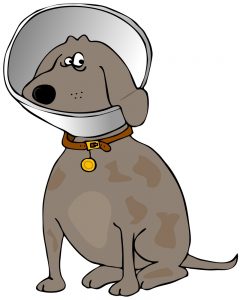Limping into December
It started with a limp. What we’d hoped was just a muscle sprain in the dog’s hind leg lingered for two months, landing us in the office of a veterinary orthopedic surgeon for x-rays.
Those black-and-white images brought bad news. Our 80-pound Goldendoodle, Mac, who never met a tennis ball he wouldn’t fetch or catch in mid-air, paid the price for his hobby when he tore his ACL. We paid the price, too, when we swallowed hard and handed over a credit card to cover the pricey surgery.
But like most animal lovers, there was never a question of what we’d do for this dog. We’d donate a kidney if he needed it. We’d dive in front of a bullet. He is family.
Thankfully, the surgery went well, but the doctor said dogs typically need up to 12 weeks to recover from this procedure, and the rules are strict. No playing. No jumping. No running. No stairs. Suddenly, our 3-year-old pup, who went everywhere as our daughter’s service dog, couldn’t go anywhere without our help.
We blocked the staircase with dining room chairs so he wouldn’t try to climb. We made a bed out of sleeping bags on the living room floor so our daughter could  sleep beside him. She had to make sure he didn’t escape from the giant cone the vet put around his head to prevent him from pulling at his stitches. But after a week of sleeping on the floor, Kate’s back was in knots, and she wasn’t getting enough sleep.
sleep beside him. She had to make sure he didn’t escape from the giant cone the vet put around his head to prevent him from pulling at his stitches. But after a week of sleeping on the floor, Kate’s back was in knots, and she wasn’t getting enough sleep.
A scene from a disaster movie titled “2012” shows an elephant suspended by ropes dangling from a helicopter, and that image gave me an idea. I bought a big sling designed to hoist up dogs with leg injuries, and now Tom and I use it each night to hoist Mac up enough so that his long, furry legs hover above the floor. Then we fly him up the stairs to sleep beside his favorite human.
We learned that aerial transport for big dogs is a young man’s game. It’s not recommended for middle-aged parents who sometimes wake up in pain in the morning because they “slept funny.” That dangling dog is heavy, and within days, my back was screaming in protest. A few days later, Tom’s back got angry, too. For the past two weeks, we’ve both been in and out of the chiropractor’s office trying to heal two bad backs triggered by one bad dog leg.
But perhaps the trickiest part of this process is trying to make sure the dog doesn’t hurt himself while he recovers from hurting himself. We’re supposed to keep him still and safe, but Mac wants to resume his daily dog business. While he was once sure-footed, he now tries to hop around the house, holding up one leg. The hardwood floors have become an ice-skating rink for this off-balance dog. He’s like a toddler who’s constantly careening toward disaster. We had to buy him rubber doggie socks to wear inside so he wouldn’t slip and fall on the way to his water dish.
All the changes around here have created stress – for the injured pup, the family, and especially the other dog – a short, bossy Corgi named Cooper. Like most dogs of his breed, Cooper thrives on consistency. Same schedule. Same people. Same food. Same setting. When anything or anyone is out of place, he notices and disapproves.
Dining room chairs blocking the staircase? That’s crazy. A bed of blankets in the middle of the living room floor? Unacceptable. Humans carrying a cone-headed 80-pound dog in rubber socks up the stairs each night? Chaos!
When Cooper feels anxious, he covertly pees on things to express his displeasure. We don’t know if it’s revenge or his way of trying to make this disorganized routine feel more familiar. Either way, it stinks.
As we try to keep our eyes glued to one dog recovering from surgery, we’re also cleaning up after the other dog, who is literally pissed about everything. He’s not alone. Could someone please pass me the eggnog? And make it a double.
Gwen Rockwood is a syndicated freelance columnist. Email her at gwenrockwood5@gmail.com. Her book is available on Amazon.
